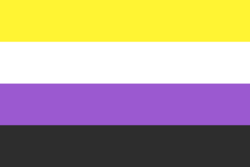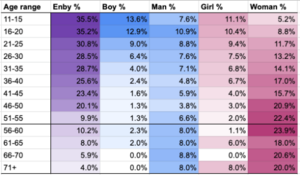Nonbinary
| ||||||
 Meaning -Giallo: genere senza riferimento al binario -Bianco: molti o tutti i generi. -Viola: genere tra le due opzioni, o un misto tra maschio e femmina. -Nero: assenza di genere. | |
| Related identities | transgender, genderqueer |
|---|---|
| Click here to see alternative flags! | |
Nonbinary (also spelled non-binary)[2] is an umbrella term covering any gender identity or expression that does not fit within the gender binary. The label may also be used by individuals wishing to identify as falling outside of the gender binary without being any more specific about the nature of their gender.
Come termine ombrello, nonbinary ha estensione simile al termine genderqueer, infatti la maggior parte delle persone che si identificano con il termine nonbinary si considerano anche genederqueer. Comunque le parole hanno significato e connotazioni diverse. Il termine genderqueer precede nonbinary di almeno un decennio.
Kye Rowan ha progettato la bandiera nonbinary, a destra, nel 2014. Questa bandiera ha lo scopo di "rappresentare la gente nonbinary che non si sente rappresentata dalla bandiera genderqueer. Questa bandiera è stata fatta per coesistere con la bandiera genderqueer di Marilyn Roxie, non sostituirla. La bandiera è costituita da quattro strisce. Dall'alto verso il basso sono giallo, bianco, viola e nero. Il giallo rappresenta coloro il cui genere esiste al di fuori del binario e non è definito in termini binari, siccome il giallo è spesso usato per mostrare qualcosa come diverso ed indipendente. Il bianco rappresenta coloro che hanno molti o tutti i generi, siccome il bianco, in ambito fotologico, è la presenza della luce e/o del colore. La striscia viola rappresenta coloro che percepiscono il loro genere come qualcosa tra il maschile o il femminile, o una combinazione di mascolinità e femminilità, siccome il viola si ottiene mischiando i due colori tradizionalmente associati le bambine e i bambini, rosa e azzurro. Il viola può essere anche usato per rappresentare la fluidità e l'unicità delle persone nonbinary. La striscia nera finale rappresenta le persone che si percepiscono come prive di genere, siccome in fotologia il nero è l'assenza di luce e/o colore." La bandiera nonbinary e la bandiera genderqueer sono entrambe opzioni che permettono alle persone nonbinary di rappresentarsi, e usano approcci diversi per simboleggiare i generi non binari.
History
See main article at history of nonbinary gender.
In 2014, Kye Rowan designed the nonbinary flag, shown at the top of this article. This flag is meant to "represent nonbinary folk who did not feel that the genderqueer flag represented them. This flag was intended to go alongside Marilyn Roxie's genderqueer flag rather than replace it. The flag consists of four stripes. From top to bottom: yellow represents those whose gender exists outside of and without reference to the binary as yellow is often used to distinguish something as its own. White represents those who have many or all genders as white is the photological presence of color and/or light. The purple stripe represents those who feel their gender is between or a mix of female and male as purple is the mix of traditional boy and girl colors. The purple also could be seen as representing the fluidity and uniqueness of nonbinary people. The final black stripe represents those who feel they are without gender, as black is the photological absence of color and/or light." The nonbinary flag and the genderqueer flag are both options for nonbinary people to use to symbolize themselves, and take different approaches to how to symbolize nonbinary genders.
In 2014, "Nonbinary" was one of the 56 genders made available on Facebook.[3]
Usage of the term enby

The word enby (plural enbies, from N-B) is an alternative word that can be used to talk about nonbinary people. It seems to have been coined by Tumblr user revolutionator in 2013 as the nonbinary equivalent of boy and girl.[5][6] As such, many people don't understand it as a full equivalent for nonbinary and instead it's often used to refer to nonbinary people of young age. The 2020 Gender Census shows how the older someone is, the less likely they are to use this word for themselves.[4]
Nonbinary identities
There is more information about this topic here: List_of_nonbinary_identities
Some of the more common identities that fall under the nonbinary umbrella include, but are not limited to:
- Agender aka Genderless, Non-gender - Having no gender identity or no gender to express (Similar and sometimes used interchangeably with Gender Neutral and/or Neutrois).
- Androgyne aka Androgynous gender - Identifying or presenting between the binary options of man and woman or masculine and feminine (Similar and sometimes used interchangeably with Intergender).
- Multigender (may also include Androgyne) - Moving between two or more different gender identities at different times/situations or having more than one gender identity at one time. Some multigender identities are bigender, polygender, and genderfluid.
- Gender Neutral aka Neutral Gender - Having a neutral gender identity and/or expression, or identifying with the preference for gender neutral language and pronouns.
- Genderqueer aka Gender Queer - Non-normative gender identity or expression. While genderqueer originated as an inclusive umbrella term, it is also considered by many to be an individual identity.
- Intergender - Having a gender identity between the two binary options of man and woman or masculine and feminine
- Neutrois - Belonging to a non-gendered or neutral gendered class, usually but not always used to indicate the desire to hide or remove gender cues
- Nonbinary or non-binary - Identifying with the umbrella term covering all people with gender outside of the binary, without defining oneself more specifically. Is also used as an individual identity in itself. One could be nonbinary butch or nonbinary femme.
- Transgender - Identifying with the umbrella term covering all gender identities or expressions that transgress or transcend (go beyond the limits of) society’s rules and concepts of gender (Transgender is a wide umbrella term also covering people who hold binary gender identities and expressions but who transgress gender by transitioning between the binary genders).
You can read about many more of these at list of nonbinary identities.
Nonbinary presentation and expression
There is no single or 'correct' way to perform a nonbinary gender. Most nonbinary people are primarily motivated by the desire to be comfortable and true to themselves rather than attempting to follow any particular gender role. Nonbinary people may or may not experience gender dysphoria or may experience only bodily or social dysphoria. Nonbinary is a wide umbrella term covering a large number of gender identities and expressions. Whichever way any particular nonbinary person needs or chooses to present, express or perform their gender is as valid as any other.
Not all nonbinary people experience gender dysphoria or follow the 'transition' narrative. Some feel that there is no social role or body to 'transition' to and so simply focus on being themselves.
Androgynous or gender neutral presentation
Some nonbinary people may choose or need to present an androgynous or gender neutral gender expression; perhaps choosing to hide, remove or blend gender cues. This is personal to each individual and is not any more nonbinary than any other way of expressing a nonbinary gender.
Some nonbinary people experience bodily dysphoria relating to certain primary or secondary sexual characteristics. The act of obscuring, removing or replacing these sexual characteristics in order to reduce gender dysphoria may result in physical androgyny without the individual having set out to specifically obtain an androgynous presentation.
Genderfuck
Some nonbinary people may choose or need to present a 'clashing' combination of gender cues that are incongruous, challenging or shocking to those who expect others to fit the gender binary. For example, combining a beard with makeup and a padded bra. This practice of transgressively breaking the rules of gender presentation is known as genderfuck, genderfucking or sometimes genderpunk.
Gender neutral language
Some nonbinary people prefer to be referred to using gender neutral language and pronouns. Some choose a gender neutral title such as Mx or Misc for formal communications. Others may opt for no title.
Expanding or subverting binary gender roles and language
Some nonbinary people prefer to expand on or subvert what is considered socially acceptable for their assigned gender. This may involve preferring binary pronouns while crossdressing, blending or mixing gender cues or otherwise subverting the expectations society places on that gender role. Some may consider this to be a political act, for others this is simply an expression of self identity or personality. Some nonbinary people have no preference for gender neutral language but instead have a preference against the language and pronouns associated with the gender they were assigned at birth.
Notable nonbinary people
See main article: Notable nonbinary people
There are many more notable people who have a gender identity outside of the binary. The following are only some of those notable people who specifically use the word "nonbinary" for themselves.
- Olly Alexander, the lead singer and songwriter for electropop band Years and Years.[7]
- Kate Bornstein, an influential writer on gender theory, publishing books on the subject from the 1990s to the present.[8]
- Amanda Stenberg, a singer and actor who has won the BET Awards for YoungStar Award.[9][10]
- Rebecca Sugar (a nonbinary woman) is a writer, songwriter, and artist whose work on the cartoon series Adventure Time and Steven Universe has earned her six Primetime Emmy Award nominations.[11]
- Sam Smith, a renowned English singer, Grammy winner and nominee. They came out as non-binary and changed their pronouns to they/them in September of 2019. [12]
Nonbinary characters in fiction
See main article: Nonbinary gender in fiction
There are many more nonbinary characters in fiction who have a gender identity outside of the binary. The following are only some of those characters who are specifically called by the word "nonbinary," either in their canon, or by their creators.
Please expand this section, giving quotes that show that the characters are specifically called by the word "nonbinary."
See also
- Gender-variant identities worldwide
- Gender designation in different cultures
- Gender neutral language
- Glossary of English gender and sex terminology
References
- ↑ This quote is a snippet from an answer to the survey conducted in the year 2018. Note for editors: the text of the quote, as well as the name, age and gender identity of its author shouldn't be changed.
- ↑ Gender Census 2018: The spelling question
- ↑ Eve Shapiro, Gender circuits: Bodies and identities in a technological age. Unpaged.
- ↑ 4.0 4.1 Cassolotl (15 June 2020). "On "enby" and age". Gender Census. Retrieved 15 June 2020.
- ↑ @cassolotl on Tumblr (September 2013)
- ↑ argentconflagration on Tumblr (November 2013)
- ↑ Years & Years: Inspiring - #PlessPlayForPride Spotify, June 7 2016
- ↑ Retrieved November 11, 2019. http://katebornstein.com
- ↑ hi folks, @dazedfields and I are organizing a workshop on feminism, amandla.tumblr.com, March 2, 2016
- ↑ Hunger Games actress says she 'doesn't feel like a woman all the time', Gay Star News, March 4, 2016
- ↑ https://io9.gizmodo.com/steven-universes-rebecca-sugar-on-how-she-expresses-her-1827624015?IR=T
- ↑ https://www.bbc.com/news/entertainment-arts-49688123

